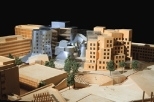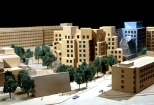MIT is moving forward with plans to build the Ray and Maria Stata Center for Computer, Information and Intelligence Sciences, working with world-renowned architect Frank O. Gehry. The project is now in the early design development phase. Construction is scheduled to begin in the first quarter of 2000, with occupancy slated for early 2003.
The Stata Center will form a new gateway to the MIT campus from Main Street and Vassar Street. Of the approximately 430,000-square-foot Center, three-quarters will be shared by the Laboratory for Computer Science (LCS), the Artificial Intelligence Laboratory (AI Lab), the Laboratory for Information and Decision Systems (LIDS), the Department of Linguistics and Philosophy, and some facilities for the Department of Brain and Cognitive Sciences and the Department of Electrical Engineering and Computer Science.
One-quarter of the center's space includes a sculptural, skylit corridor called the student street, five major classrooms, unassigned "incubator" research space, a day care center for 80 children, athletic space adjoining the existing Alumni Pool and a subterranean materials handling center.
"Physically integrating our computer science facilities into the core of the campus has been a goal for many years. The state-of-the-art facility we envision will facilitate learning, research and interaction within EECS and across disciplinary boundaries. This project is essential from both academic and long-range campus planning perspectives," President Charles M. Vest has said.
"For many years, people in the Department of Electrical Engineering and Computer Science have longed to return the computer scientists to the main campus from Technology Square. But this great new facility is much more than simply a solution to a long-standing problem in proximity. The innovative structure will demonstrate architecturally the intellectual stature these disciplines have achieved," said Thomas L. Magnanti, dean of the School of Engineering.
The Stata Center will occupy the Vassar Street site where Building 20, the fondly recalled barracks-like home of the Radiation Lab, stood until this spring. Building 20 was erected in 1943 as part of the US war effort, and it remained a vital part of MIT life until it was razed. During the planning stages of the Stata Center, the vitality of community discussions arose from a desire to maintain the spirit of the "magical incubator," as Building 20 became known. (A Building 20 time capsule is being produced, to be displayed in the Stata Center lobby and unsealed 55 years from now.)
A major goal of the new complex is to create an environment that promotes frequent social and intellectual interactions within a community of neighboring research groups. The Stata Center is envisioned as a model for innovative, technologically supported education, an incubator for new ideas and technology and a hub of student activity.
Provost Robert Brown, leader of the client team working with Mr. Gehry, has said, " The Stata Center will create a new paradigm for an academic community within MIT by mixing teaching, research and recreational activities in one location in a way that transforms the northeast sector of campus."
ARCHITECT'S VISION
Mr. Gehry has recently received worldwide acclaim for his design of the sculptural, titanium-clad Guggenheim Museum in Bilbao, Spain, completed in 1997. The design principal of his firm, Frank O. Gehry & Associates, he has received more than 100 awards from the American Institute of Architects (AIA), and his work has garnered several of the most significant awards in the architectural field. He has received more than 30 prestigious international awards and honors including the Pritzker Architecture Prize, the NEA National Medal of Arts, the AIA Gold Medal and the Praemium Imperiale Award from the Japan Art Association.
"Frank's work has always been characterized by extraordinary inventiveness and resourcefulness," said William Mitchell, dean of the School of Architecture and Planning. "He uses amazingly fresh and inventive techniques to produce architecture with to-the-point, computer-aided design technology, three-dimensional models and physical prototyping, thus pushing the boundaries of architecture in exciting new directions."
Mr. Gehry, noted for his innovative use of high-tech materials and computer-aided design, has not designed a new structure in the Boston area. His lone Boston landmark is a redesign project in which he collaborated with a local architectural firm, Schwartz/Silver, on what is now the Tower Records building at the corner of Newbury Street and Massachusetts Avenue in Boston.
Mr. Gehry's vision for the Stata Center is to achieve numerous goals simultaneously. It is not only to define the Center as a home for all of its occupants, but also to enhance the Vassar Street edge of the campus, to create an exciting space for researchers and exciting common areas for the entire MIT community.
The design calls for two 120-foot towers placed on a wider base referred to as the "warehouse" because of its height. The central place where these three elements meet, at the third floor terrace, is where Mr. Gehry's design spirit shows most clearly.
"The design of the research spaces is being developed around the concept of neighborhoods. In the Stata Center, the neighborhood, [consisting] of a lab or a department, expands vertically as well as horizontally. Open, double-height spaces... nurture the sense of community that exists among various families in a neighborhood. Connectivity among labs and departments is accomplished by creating a village or community center at the intersection of the warehouse and the two towers. The current scheme should lead to an architecture that creates curiosity, expectation and excitement," Mr. Gehry and his team have written.
"The heart of the complex shows the potential for both significant architecture and successful open spaces in the way it engages its site, unifies the two towers and becomes an expression of interaction within the research community," they wrote.
Mr. Gehry has designed a crescent-shaped student walkway and community area on the ground floor of the Stata Center to extend the interior street that is established by the Infinite Corridor.
Another "street," located on the center's third floor, includes a reading room, conference rooms, a terrace linking the various groups in the towers and a caf�.
THE DONORS
MIT is naming the new facility in honor of Maria and Ray Stata (SB 1957), co-founder and chairman of Analog Devices, who have given $25 million, the largest gift ever received by the Institute for a building project.
"This design will catalyze the interaction of students and faculty and stimulate invention and exchange of ideas across many disciplines. Even in this age of instant electronic communication, there is no substitute for the casual, creative personal contact that this new complex will facilitate," said Mr. Stata.
The new facility is being supported by the generous gifts of several major donors. Alexander W. Dreyfoos, Jr. (SB 1954), chairman of the Dreyfoos Group/Photo Electronics Corp., has pledged $15 million. One of the two towers in the complex, which will house the AI Lab, LIDS and the Department of Linguistics and Philosophy, will be named for him.
"I'm excited at the wonderful opportunities for the cross-pollination of ideas, in fields of study which will see great advances in the coming decades. I hope that the new center will make an architectural statement that will be to the 21st century what the original MIT Cambridge buildings have been to the 20th century," said Mr. Dreyfoos.
The second tower, which will house the LCS, will be named the William H. Gates building. Through the Gates Foundation, Bill and Melinda Gates made a gift of $20 million to MIT for the center.
"The MIT Laboratory for Computer Science is one of the most important centers for computer research in the world. I'm happy that this gift will be used to support continued innovation in computer science and the ground-breaking research for which LCS is known," said Mr. Gates.
A version of this article appeared in the June 2, 1999 issue of MIT Tech Talk (Volume 43, Number 32).







